This brief hands-on field review is part of a larger series of ongoing articles and reviews of
medium format digital backs. If you have not already done so you might wish to begin
by reading myDigital Back Surveyand then refer to the other reviews in this series
that are linked at the bottom of that page.
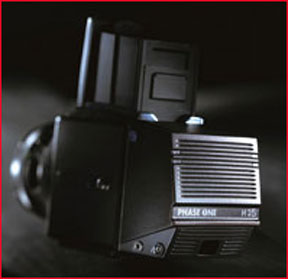
This is not a comprehensive review of thePhase One H2522 Megapixel medium format back. My friends atVistek, Canada’s largest professional imaging dealer, were kind enough to lend me one for a few days, along with aHasselbladsystem to test it on. Because of the short time period involved this review is necessarily just my impression of how well the back performs under some basic testing conditions.
Along with theLeaf Valeo 22, thePhase One H25is the second 22 Megapixel medium format back to ship during the third quarter of 2003. What makes the H25 different than the Valeo 22 and the other medium format backs that I have been reviewing during the past few months is that it needs to be connected to a computer when shooting, even in the field. While theKodak,ImaconandLeafbacks tested thus far in myDigital Back Surveycan all work in tethered mode, they all have as well self-contained battery and mobile storage alternatives. At this time the H25 does not.
This makes theH25much more suitable to studio applications than work in the field, though as will be seen, field work isn’t completely out of the question.
In several previous reviews I have done comparisons with my ownKodak DCS Pro Back 645. In this instance I have decided not to do a detailed comparison, but rather to look at theH25simply on its own merits. When it is clear that theH25is either superior or falls behind either the Kodak back, or any of the other backs that I’ve reviewed recently, I’ll make that comparison.
TheH25has a MSRP of U.S. $29,990. (No, I can’t afford it either, but it’s interesting to know what’s happening with the state-of-the-art.)
Matching Cameras
ThePhase One H25will work with almost any Hasselblad "V" series camera. My tests were done with aHasselblad 555ELD. The back will mate with theMamiya RZas well as theFuji GX680. An adaptor plate will allow the H25 to be mounted on just about any 4X5" view camera as well.
This back will not currently work with any of the popular 645 autofocus cameras, such as theHasselblad H1,Contax 645, orMamiya 645AF. There have been rumours on the Net about such an offering, and I wouldn’t be at all surprised if something along these lines were to be announced at thePMAshow in February, 2004.
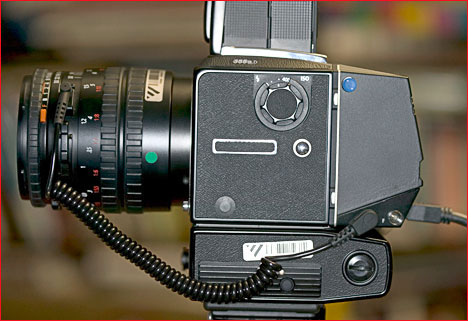
Phase One H25 on Hasselblad 555ELD
with Zeiss 120mm f/4 Makro Planar
In The Studio
The H25 is happiest in the studio, where it connects directly to a PC or Mac for image transfer and for power. Both data and control signals as well as power are carried via a 6 pin Firewire connector on the back’s rear panel. This panel also contains two LEDs that illuminate when the back is connected and powered on. The H25 back does not require a fan orPeltiercooler of any sort.
As seen in the illustration above a cable needs to be connected between the leaf shutter lens’ PC flash sync contact and the H25 back. This tells the H25 when to be ready to expose the chip. A second cable is needed between the motor base of the Hasselblad 555ELD and the H25 if you want to be able to "shoot" from the computer.
The back attaches just as does any film back. Because the imaging chip is rectangular (just short of full 645 size) and it is used on a 6X6 square format camera, the back can be mounted so that the chip is either vertical or horizontal. It removes with a press of a button, but to ensure that this expensive chunk of metal and glass doesn’t accidentally take a header there is a set screw that can be turned to lock the back to the camera. (Of course the whole camera can be turned sideways for shooting verticals instead of turning the back). A portrait studio though, for example, might want to affixed the back preeminently in the "portrait" position.
Files produced are 127MB in 16 bit mode once they’ve been expanded from RAW mode. On disk as RAW files they are 46 MB in size.
Incidentally, the sensor is covered by the usual IR filter, but not an antialiasing filter.
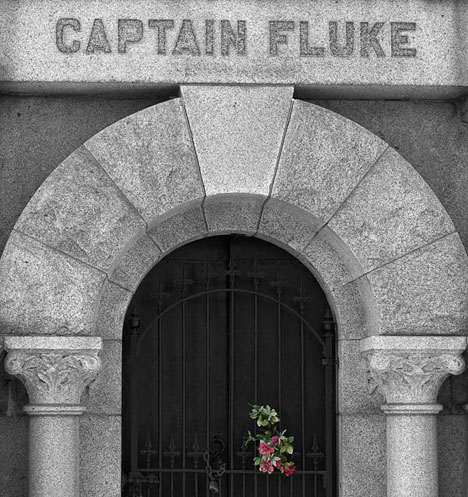
Captain Fluke — Toronto, December, 2003
Hasselblad 555ELD with 120mm f/4 Zeiss Makro Planar
The making of the photograph is discussed
inMiscellaneous Momentsfor December, 2003
Capture One Software
The back I received came with V3.01 ofPhase One’sCapture Onesoftware. V3.1 had just become available a few days before my tests so I downloaded it, and it is what I used during my testing.Capture Onefor theH25is essentially the same software that has become so famous over the past year for use with Canon and Nikon DSLRs. Its fame is justly deserved. From the point of view of both workflow and image quality there simply isn’t RAW image conversion software that I have yet seen that is as easy to use and as full-featured and "professional " asCapture One.
Tethered On Location
Just as in the studio one has the choice of working on either a Mac or Windows platform. Of course for field work you are going to want to use a laptop, and whichever platform you use will present unique difficulties.
If you use a Mac you do not need to use a separate power supply or battery, because Macs have full-sized powered 6 wire Firewire sockets, and so the H25 can get its juice directly from the Mac. But, Mac laptops can’t operate when their lid is closed, and therefore you have to find a place to put your open computer while shooting. (I have not tested this myself, but I’m told that an H25 can drain a fully charged Mac laptop in a very short time, so the outboard Phase One battery is almost a must in any event).
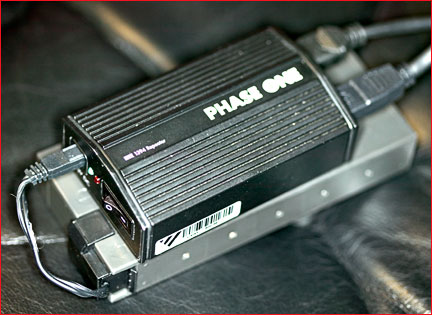
Lead Acid Battery and Firewire Junction Box
Windows laptops (assuming they have a Firewire connection (which most do)), all have 4 wireunpoweredconnectors and therefore you must use Phase One’s "Mobile Solution", which consists of a small Firewire junction box coupled to a Panasonic Lead Acid battery. (More stuff to schlep). But, the good news is that Windows XP laptops can be configured through theirPower Optionsettings inControl Panelto operate with the screen closed. This means that if you’re willing to forego looking at a histogram you can shoot on location with the closed laptop, junction box and battery in a small shoulder bag, and just the Firewire cable running from the bag to the H25 back.
While this sounds like a workable solution, I didn’t find it to be so. I spent one afternoon working this way and it was fraught with annoyances. This is simply not in my mind anything more than averyoccasional option.
Also, the Firewire cable isn’t the only one required. As mentioned above there is the sync cable from the lens’ PC socket to the back, and if you’re using a motorizedHasselblad 555ELD, as I was, there is an additional cable from the motor base to the H25 so that you can trigger the back from the computer.
So, while shooting on location is certainly possible with the H25, it does require more cabling than other digital backs tested thus far, and of course a laptop computer needs to be in the bag as well — open or closed.
Colour Reproduction
This test shot was taken in my office using anIaniro3200K tungsten quartz 1000W lamp. Colour balance in the software was set to tungsten, and the only additional colour balancing done was to select the 18% gray patch on theMacbethcart. I used tungsten lighting since I assume many photographers will predominantly use the H25 under these lighting conditions.
TheH25back was mounted on aHasselblad 555ELDand aZeiss Makro Planar 120mm f/4was used.
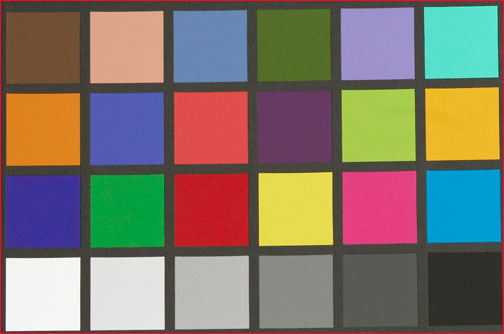
Macbeth Colour Chart
I have examined many digital back’s and digital camera’s colour reproduction capability, and I can say without reservation that the H25’s is the most accurate that I have ever seen. The only obvious deviations that I see are that the "magenta" square is a bit pinker than it should be, and the "moderate red" square a bit warmer.
This is remarkable performance. Of course any back or digital camera can be profiled to remove minor discrepancies, but by looking at the back’s unaltered colour output one can see how well the designers have fulfilled their design brief. In this case, to as high a level as I’ve ever seen.
Resolution & Noise
The resolution of the H25 is startling. Even though the H25 was on a Hasselblad, and I was testing against my Kodak DCS Pro Back on a Contax 645, both cameras (by coincidence) had the remarkableZeiss 120mm f/4 Makro Planar. I was able to shoot side by side tests. The lenses were presumably similar in performance, or at least close in image quality, the only variable was the resolving capability of the back. In frame after frame the H25 outresolved the Kodak back. And not by just a little. By a noticeable margin, on screen and on prints.
Why? I can’t really say. But in the testing and comparisons that I’ve done thus far with other backs, like theImacon IxpressandLeaf Valeo 22, I never found that they displayed any significant resolution advantage over the Kodak. More pixels overall, yes — in the case of the Valeo 22, but since all of these cameras have approximately 8 micron pixels at the same pixel density one would think that their resolving capabilities would be comparable. They’re not. The H25, as I’ve said, and much to my surprise, clearly is superior.
As far asnoisegoes, I mainly used the H25 at ISO 100, where I found it to be essentially noiseless. But I also ran tests at ISO 400. I saw little increase in noise, though dynamic range did become compressed. Also, there were cases where even a 1/2 stop change in aperture at this ISO would lead to shots thatCapture Onedeclared as being eitheroverexposedorunderexposed. I didn’t have the time to explore this anomaly in greater detail.
And The Winner Is?
As of writing this in December, 2003 I have tested four of the current medium format digital backs, and own myself theKodak DCS Pro Back. There is no question in my mind, based on the testing and the many hundreds of frames that I have shot with all of these cameras (thousands on the Kodak), that thePhase One H25is head and shoulders above every other medium format back that I have used. It excels in every category, except portability.
Resolution is visibly superior to all other backs — even those with ostensibly the same pixel size and resolution. Colour reproduction is exemplary, and noise levels range from non-existant to hardly visible.
If I were a studio photographer I’d hock my car to get an H25. It’s that good. But, since I work exclusively on location, and often in pretty remote and rugged locales, this isn’t a digital back that I could call my own. Having to work with a tethered computer is too awkward by far. But, if and whenPhase Onebrings out a version that fits theContax 645, and that is able to function in a self-contained manner — who knows? I may even think about hocking my car. The Phase One H25 that good!
